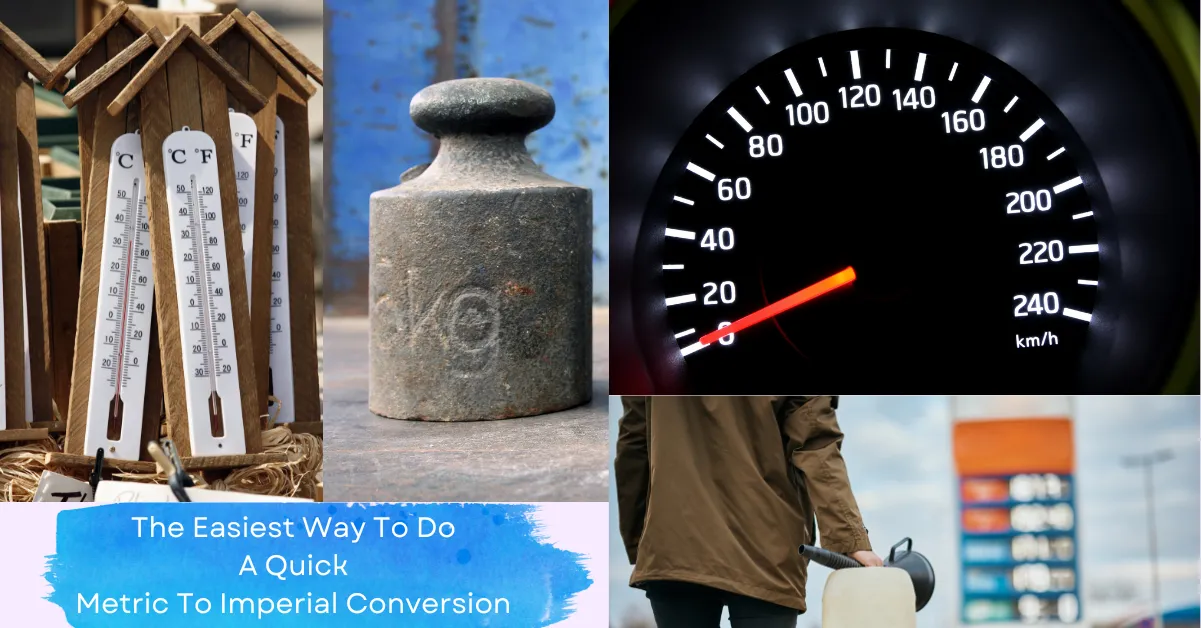Metric to Imperial Conversion: Are you tired of constantly messing up your recipes because of inaccurate cup measurements? Having your baking creations go wrong because of a simple measurement error can be frustrating. But fear not; there is a simple solution to ensure perfect cup measurements every time!
-
Metric to Imperial Conversions in the UK vs the US
- Convert Length From Metric To Imperial (Meter to Foot)
- Temperature Converter From Metric To Imperial (Celsius to Fahrenheit)
- Converting Mass From The Metric To The Imperial System (Kilogram to Pound)
- Convert Volume From Imperial to Metric (Gallons to Liters)
- Speed/Velocity Converter
- Convert Ounces to Cups and Tablespoons
- Accuracy of metric to imperial conversion - Tips and Tricks
- Why is the Metric to Imperial Conversion Necessary?
Following the tips and tricks in this article, you can measure ingredients accurately and confidently for all your culinary endeavors. Say goodbye to ruined dishes and hello to consistently delicious results. With just a few easy steps, you’ll be on your way to becoming a master at perfect cup measurements. Get ready to impress your friends and family with your baking skills!
Metric to Imperial Conversions in the UK vs the US
A quick and free online unit converter that converts standard units of measurement. A unit conversion expresses a property in terms of another unit of measurement.
Length – Distance
| Symbol | When You Know | Multiply By | To Find | Symbol |
|---|---|---|---|---|
| mm | millimeter | 0.04 | inch | in |
| cm | centimeter | 0.39 | inch | in |
| m | meter | 3.28 | foot | ft |
| m | meter | 1.09 | yard | yd |
| km | kilometer | 0.62 | mile | mi |
Convert Length From Metric To Imperial (Meter to Foot)
Temperature
| Symbol | When You Know | Calculation | To Find | Symbol |
|---|---|---|---|---|
| °C | degree Celsius | multiply 1.8, then add 32 | degree Fahrenheit | °F |
| K | Kelvin | subtract 273.15 | degree Celsius | °C |
Temperature Converter From Metric To Imperial (Celsius to Fahrenheit)
Mass (weight)
| Symbol | When You Know | Multiply By | To Find | Symbol |
|---|---|---|---|---|
| g | gram | 0.04 | ounce | oz |
| kg | kilogram | 2.20 | pound | lb |
| metric ton (1,000 kg) | 1.10 | short ton |
Converting Mass From The Metric To The Imperial System (Kilogram to Pound)
Unit conversion for Area (Formula)
| Symbol | When You Know | Multiply By | To Find | Symbol |
|---|---|---|---|---|
| cm² | square centimeters | 0.16 | square inch | in² |
| m² | square meter | 1.20 | square yard | yd² |
| km² | square kilometer | 0.39 | square mile | mi² |
| ha | hectare (10,000 m2) | 2.47 | acre |
Volume Converter – Metric to Imperial Conversion
| Symbol | When You Know | Multiply By | To Find | Symbol |
|---|---|---|---|---|
| mL | milliliter | 0.03 | fluid ounce | fl oz |
| mL | milliliter | 0.06 | cubic inch | in³ |
| L | liter | 2.11 | pint, liquid | pt |
| L | liter | 1.06 | quart, liquid | qt |
| L | liter | 0.26 | gallon | gal |
| m³ | cubic meter | 35.31 | cubic foot | ft³ |
| m³ | cubic meter | 1.31 | cubic yard | yd³ |
Convert Volume From Imperial to Metric (Gallons to Liters)
A speed/velocity converter ensures accuracy, safety, and efficiency in international travel, engineering, sports, research, and education. It promotes consistency across measurement systems, helping individuals and organizations adapt to different contexts without confusion.
In short, it’s an essential tool for global communication, safety, and precision in everyday and specialized applications.
Speed/Velocity Converter
A cups and tablespoons converter is essential for the following:
- Accurate recipe measurements
- Adapting to different kitchen tools and systems
- Global recipe sharing and international collaboration
- Precise portion control for nutrition tracking
It bridges the gap between measurement systems, ensuring consistency, precision, and convenience in home and professional kitchens. Whether baking a cake, following a diet plan or preparing a meal from an international recipe, this converter ensures everything turns out just right.
Convert Ounces to Cups and Tablespoons
Accuracy of metric to imperial conversion – Tips and Tricks
- Use Conversion Charts: Keep a conversion chart handy. It’s like having all the answers to a test!
- Double-Check Your Math: A simple mistake in multiplication or division can throw everything off.
- Estimate Before Converting: A rough idea of the answer can prevent silly mistakes.
- Use Online Tools for Complex Conversions: Online calculators can be a lifesaver for tricky conversions.
- Remember Significant Figures: The number of digits you write down in science and engineering matters. Ensure you’re not implying more precision than you actually have.
Challenges and Common Mistakes
- Mixing Up Conversion Factors: It’s easy to flip numbers. Remembering whether to multiply or divide can be challenging.
- Forgetting Units: Always write down the units of measurement. Losing track of whether you’re dealing with inches or centimeters can lead to confusion.
- Temperature Trouble: Converting temperature isn’t as straightforward as length or mass. Please pay special attention to the formulas and don’t mix them up.
Overcoming Challenges
- Practice: The more you convert, the more familiar the process becomes.
- Use Mnemonics: Create little sayings to help remember conversion factors.
- Check Your Work: Review your calculations to catch any errors.
Unit Conversion in Everyday Life
Knowing how to convert units is incredibly useful:
- Cooking: Recipes often use different units of measurement. Converting correctly can mean the difference between a culinary delight and a dinner disaster.
- Travel: If you’re driving in a foreign country, you might need to convert between miles and kilometers.
- Shopping: Comparing prices in different units (per ounce or gram) can help you get the best deal.
- Home Projects: Imagine buying a carpet or painting a room. You’ll need to convert measurements to buy the right amount of materials.
Why is the Metric to Imperial Conversion Necessary?
Unit conversion is a fundamental concept essential in various fields, including science, engineering, cooking, and everyday life. It enables us to express quantities in different units, allowing for seamless communication and consistency across measurement systems. Comparing or combining measurements from other sources would be impossible without unit conversion.
Understanding unit conversion is essential for accurate and precise calculations. Whether you’re solving a physics problem, converting a recipe from metric to imperial units, or estimating distances on a road trip, having a solid grasp of unit conversion ensures that your calculations are correct and reliable. It empowers you to make informed decisions based on accurate measurements, eliminating the risk of errors or misunderstandings.
Note: Double-check your calculations – unit conversion errors can occur quickly if you make mistakes in your calculations. Always double-check your work and verify that the converted measurement makes sense in the given context. If possible, compare your result with known values or use alternative conversion methods to confirm accuracy.
Why Use a Conversion Calculator or Conversion Table?
A conversion calculator or table can save time and effort when converting between metric and imperial units of measurement. These tools provide accurate and reliable conversions, ensuring you always get the correct measurement. Whether you’re working on a DIY project, cooking a recipe from a different country, or need to convert measurements for work or school, a conversion calculator or table can be handy.
Conversion Table for Quick Reference or a Metric to Imperial Conversion Tool?
If you prefer to have a quick reference guide for converting between metric and imperial measurements, you can use a conversion table. A conversion table typically lists common measurements and their equivalents in both metric and imperial units, making it easy to find the conversion you need.
Keep a conversion table handy, in either print or digital format, to always have a reliable resource for converting measurements at your fingertips.
Conclusion
Metric to Imperial conversions don’t have to be daunting. With the help of a conversion calculator or table, you can easily switch between different measurement systems with confidence and accuracy. Whether you’re working on a project at home, cooking in the kitchen, or studying for a math exam, having the right tools for conversion can make your life easier and more efficient.
Share this:
- Click to share on Facebook (Opens in new window) Facebook
- Click to share on Pinterest (Opens in new window) Pinterest
- Click to share on LinkedIn (Opens in new window) LinkedIn
- Click to share on X (Opens in new window) X
- Click to share on Tumblr (Opens in new window) Tumblr
- Click to share on Bluesky (Opens in new window) Bluesky



Very useful.Thanks for sharing!
Thanks Nikki
You are so welcome!
After reading your article, I have a different way of thinking
I always keep a conversion chart handy on my phone. It’s saved me so many times, especially when dealing with recipes or international projects.